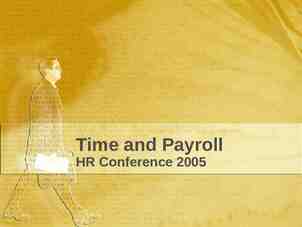ART Conference 2018 Royston What keeps people ringing? Pip
25 Slides3.61 MB

ART Conference 2018 Royston What keeps people ringing? Pip Penney www.ringingteachers.org

Why do you ring? The answer is BECAUSE YOU ENJOY IT! But everyone is different and as ringing teachers we need to understand different types of people who want to learn to ring! 2

Recruitment and retention – two very different skill sets Has your tower recruited new ringers in the last two years? How many of the people you recruited over the last two years are still ringing? Has your tower recruited new ringers in the last five years? How many of the people you recruited over the last five years are still ringing? Has your tower recruited new ringers in the last ten years? How many of the people you recruited over the last ten years are still ringing? 3

What can hobbies such as ringing do for people? Dr Edward A Drefus [Psychologist] Hobbies provide a point of connection with other people Build self-esteem Relieve stress Give a broader perspective Make people more interesting With all this going for us surely we should retain everyone! 4

What can hobbies such as ringing do for people? McCullagh – University of Colorado [1993] Published some research which had studied the deeper reasons for people participating in hobbies and pastimes: 1.Affiliation 2.Mastery 3.Sensation 4.Self direction 5.Social Comparison Which group do your ringers fall into? 5

NCVO – National Council for Voluntary Organisations Factors affecting participation – research results: Participation is personal and must be viewed first and foremost from the perspective of the individual taking part The relationships that are built in groups are a crucial sustaining factor in people’s participation When groups work well they provide individuals with fun, friendship, companionship, a social life Good quality participation experience was the single most important reason interviewees gave to explain their sustained participation Good quality resources lead to a good quality participation experience 6

Participation What implications does this information have for us? 7

Three main barriers to participation Negative relationships within groups Groups that are unwelcoming, insular or cliquey Feeling unappreciated, disempowered, Disillusionment, frustration or cynicism about their involvement Bad experiences lead people to reconsider and sometimes entirely stop their participation Poor group structures and processes Practices that are poorly run, tedious and do not result in any progress Absence of support (including training, access to opportunities, emotional or psychological support) Life events e.g. moving house, changing job, illness 8

Three main barriers to participation What implications does this information have for us? 9

Who does ringing need to keep ringing? Llandaff & Monmouth DACBR Jan 2018 40% of ringers are over 65! 10

Do we need to consider children differently? ? 11

Children are different 10 to 13 year olds See ringing in terms of having fun rather than being motivated to learn methods Like having their photo taken Like having rewards such as certificates awarded in public This is a stage for fun and skills development 12

Children are different 14 to 16 year olds This is the age of maximum peer group pressure – they do not want to step out of line with their mates! They get shy about having their photo taken Do not like being awarded certificates in public such as a branch but prefer to have them awarded within their own tower They want to start getting to grips with new things such as learning methods and calling things 13

Children are different 17 years plus At this stage they may start to take their ringing seriously They can be treated like adults for the purpose of teaching method ringing However not all will go on to take it seriously There are two pathways ringers pursue: 1.Progressive – keen to learn more and improve 2.Participatory – just want to stay involved with no pressure 14

Participation – progressive [performance development] 15

Different types of teachers needed? 1. Teaching for continued participation 2. Teaching children and those under-16 3. Performance development teaching [progressive pathway] 4. High performance teaching Different skills required for each? Do we need to train different types of teachers/coaches? 16

Life-long ringing – retaining everyone? Dr Istvan Balyi [Psychologist] 1998 published the first of 3 papers covering the long term development of participants from children to those of retirement age: Each age is catered for Long term athlete development [LTAD] Some sports such as canoeing, tennis and swimming have used the results of his research to develop a life-long participatory pathway for those involved 17

Learning for life long involvement [Istvan Balyi] Stages of long term development FUNdementals 9 to 11 years All about having fun and enjoyment Building the basic skills accurately This approach is more likely to lead to long term involvement Learn to train 10 to 12 years Skills development Train to train Train to Active for life compete 12 to 16 years 16/17 Any age group onwards Building Reaching the A smooth to stamina and v highest levels lifelong indurance physical Only the most activity and Ddedicated reach participation in this level sports. Those not performing so well at this stage should not be overlooked. Some will come on later Learning to cope with the mental and physical requirements of change ringing Many participants don’t get to this level Goal to keep everyone involved for life 18

Ringing could develop a plan for life! 19

Through the autumn of 2004 the BCU worked to fine tune the LTAD The BCU – British Canoe Union plan into a LTPD or Long Term Paddler Development plan 20

Long-term paddler development plan [LTPD] 1. FUNdamental stage Basic skills development in a positive fun environment 2. Paddlesport start stage High quality skills development in a structured manner 3. Paddlesport development stage Introducing different environments 4. Recreational paddlesport Help paddlers to maximise the enjoyment and satisfaction in the time they have available for paddlesport 5. Performance paddlesport For those wishing to maximise their potential. For those who wish to compete as well as those who don’t 21

British Canoe Union – teaching structures 22

LTAD framework adopted for swimming 1. FUNdamentals Basic movement literacy 2. Swim skills Building technique 3. Training to train Building the engine/ aerobic conditioning 4. Training to compete Optimising the engine / physical conditioning 5. Training to win aged 16 – 18 Maximising the engine and performance enhancement 23

What could ringing do to develop life-long participation? Should ringing be thinking along these lines? Do we need to think about a life long development plan? An activity for all ages With the reorganisation of ringing does this provide us with a golden opportunity to think about the future organisation? 24

I leave you with three questions Can we learn from research done by others? Do we need to consider children differently? Do we need to train different types of teachers or coaches? 25






